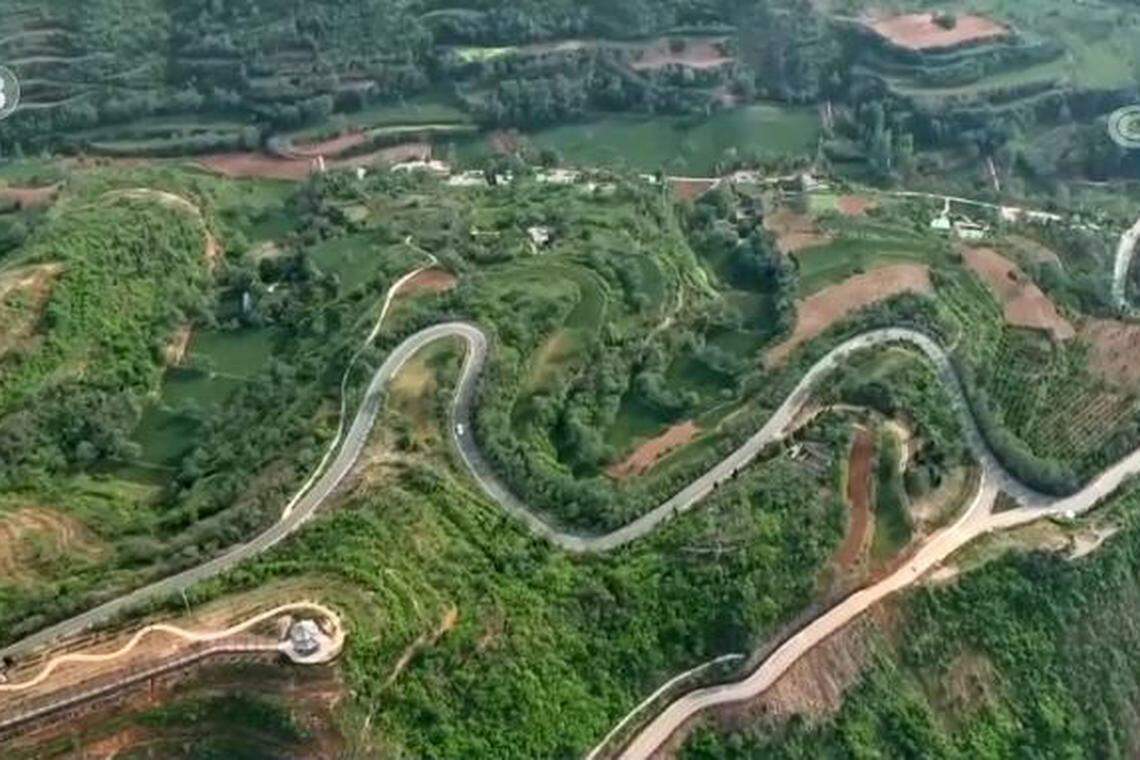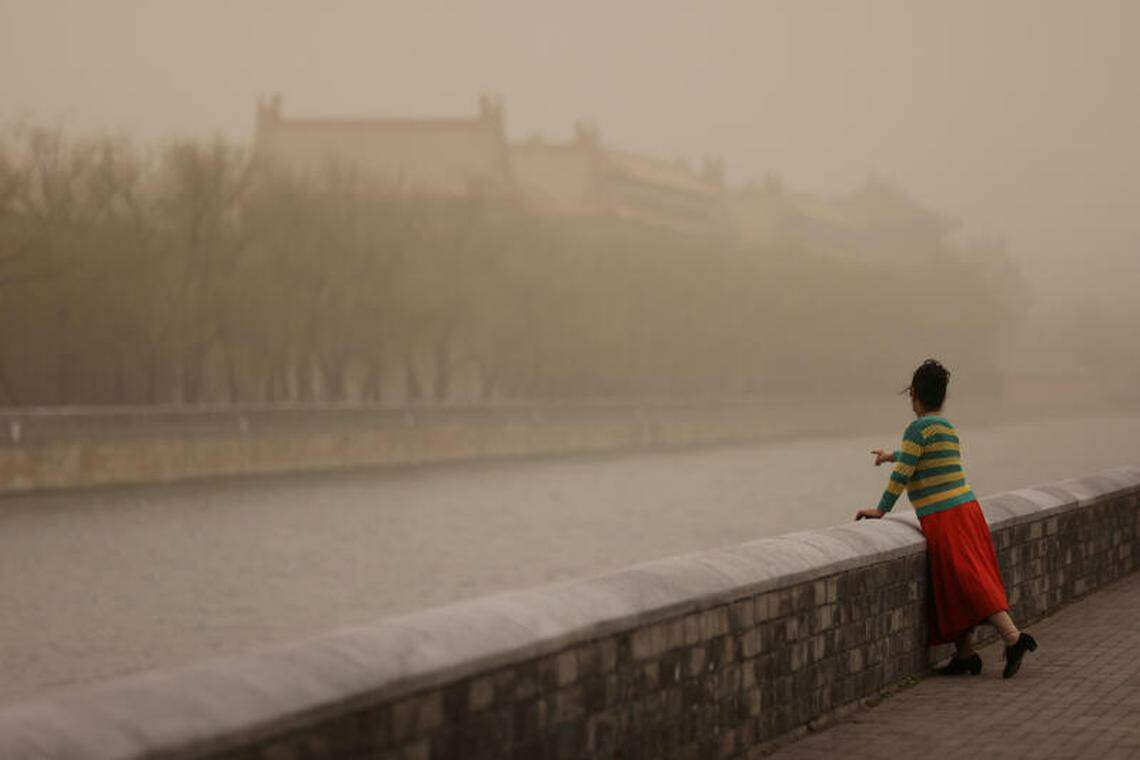The Beijing Meteorological Observatory was upgraded to release the sandstorm warning signal on Monday (April 10) in the evening, which raised the blue tone to yellow. The Beijing urban area was shrouded in yellow sand that night. Most of the regions were less than 1,000 meters.I ca n’t eat soil.
After one night of sand and dust baptism, the air quality in Beijing was in the highest level of severe pollution, and the PM10 concentration in most regions broke through thousands.Local media reported that the visibility near the urban deputy center of the river was only about one kilometer.
Due to the impact of sand and dust, the light on the ground looks red, and the overall color is blue. There is also a common phenomenon in sand and dust weather above Beijing.
What is the taste of sandstorms?
Sandstorm refers to the storm that blows the ground dust and sand to make the air very turbid. The horizontal visibility is less than 1000 meters. It has the characteristics of sudden and duration.
As a sign of wind erosion desertification, sandstorms mainly occur in winter and spring.There are very little precipitation in semi -drought and dry areas in winter and spring. The surface is extremely dry and loose, and the wind resistance ability is very weak. When there is a strong wind over, a large amount of sand and dust will be involved in the air, forming sandstorm weather.
Faced with the heavy soil of sandstorms, northern netizens who have already prepared many war experience could not help but vomit: the familiar formula, or the familiar color number, the amount of dust is like eating the soil.
Visually, Beijing International Trade and Bird's Nest, which are close at hand, can't see clearly.In terms of sense, some netizens said that in the morning, they were awakened by the fragrance of dirt.The online picture shows that a layer of soil has accumulated on the shared bicycle seat at the door of the subway. After wiping a wet scarf, it wipes darker and darker, as if he is with mud.

Netizens showed out the gray soil on the bicycle (Internet)

Netizens talked about Beijing sandstorms.(Internet)
In fact, in addition to Beijing, Xinjiang, Inner Mongolia, Gansu, Ningxia, Shaanxi, Tianjin, Shandong, Henan, Jiangsu, Shanghai, including 18 provinces and regions and cities, there are sand or dusty weather.The sandstorm may affect Jiangsu, Zhejiang, Shanghai and Shanghai sandstorms as a result.
However, not all sand and dust weather is sandstorms.In terms of meteorology, according to the influence from light to heavy, sand and dust weather can be divided into dust, sand, sandstorms, strong sandstorms, and special strong sandstorms.Judging from the information feedback from Shanghai netizens, the local area has not reached the level of sandstorms.
Beijing Shachen Blchida
There have been tens of millions of years in the history of the earth, but the appearance of human beings and the accompanying reclamation felling behaviors make this weather become more and more extreme.
As early as the late Qing Dynasty, Western people who lived in Beijing, the capital of China, talked about the distress of sandstorms.In March 1891, the translator of the German Embassy in China wrote in the letter: In the recent period of time, Hellip; Hellip; wind and sand are very large.For walking, the dust on the street was already very thick, and now the dust is covered with walls.
The German Mission to China Elizabeth Middot; Feng Middot; Haijing wrote in 1897: My physical response to the streets of Beijing is like a person who is very disgusting to me.hellip; hellip; scratching terrible sandstorms in the sky, the severe coldness outside the house.
Lin Yutang, a well -known Chinese writer, recalled in Beijing in Beijing in the 20th century: People have to prepare at least once a year to deal with the strong windsheart from the Mongolian desert; then the sky is dark and the sun looks yellow.
Due to unreasonable development, vegetation in China was severely damaged in the 1960s.According to the statistical analysis of the information of the sand and dust in Beijing, in the 1960s and 1980s, the number of sand and dust in Beijing in the spring of Beijing was more than 10 to 20 days.Beijing also set a 20 -day sandstorm weather record in 1966.
However, with the launch of the China Sanbei Forestry Project and the subsequent attention, the problem of sand and dust began to pay attention to the problem of sand and dust, and returned farmland to the forests. After 2010, the average daily sand and dust of Beijing were reduced to about three days.

China Sanbei Protective Forestry Project (CCTV video interception)
However, by 2021, Beijing, Mongolia and other places have suffered the largest sandstorm in 10 years.Chinese netizens said at the time that they had not seen such a scene for many years.
Unexpectedly, just two years later, the sandstorm attacked Beijing again.From the 19th to 23rd last month, Beijing ushered in the strongest sandstorm weather this year. Netizens described the excavation scene at the Terracotta Warriors No. 1.
Seeing that the situation improved for a while, he killed another carbine in April, allowing Beijing to encounter the fourth sand and dust in Beijing this year.
Gui Hailin, chief forecaster of the Central Meteorological Observatory, introduced that this time the sand and dust weather is not the worst this year. The sand and dust weather in March is defined as a strong sandstorm level according to the standardEssence
According to the release of the Beijing Ecological Environment Monitoring Center, by 12 noon on Tuesday, the city's air quality has changed from severe pollution to moderate pollution, and the situation is turning.
According to the prediction of the Central Meteorological Observatory, the sand and dust weather will be further expanded.It is expected that from the 13th to 14th, the weather or dusty weather in the east, North China and other places in the northwest region will occur.Experts predict that there will be some sand in Beijing, but the intensity will weaken compared to the process.

Except for Beijing, Xinjiang, Inner Mongolia, Liaoning, Jilin, Henan, Jiangsu, Shanghai and other 18 provinces and regions and municipalities have sand or dusty weather.The picture shows the streets of Shenyang, Liaoning on Tuesday.(AFP)
The problem of sand and dust that has been governed for many years has come back?
Since 2000, the number of sandstorms in China has shown a decrease in the trend, but the frequency of the occurrence of the past two years has been signs of reunited.The current sand and dust weather process is the eighth time since this year, and the number of sand and dust in the same period of the same year is about five to six times.

From March 19th to 23rd, Beijing ushered in the strongest sandstorm this year, which was more serious than the sandstorm in April.(Reuters)
Although China has made progress on the problem of sand prevention through tree planting in recent years, data from China Forestry and Grass Bureau shows that China still has 2.5737 million square kilometers desertized land and 1.6878 million square kilometers.Sandy land.Another more tricky and more important source of sand is the Gobi Desert in Mongolia.
The Gobi Desert is also known as Gori.It has an area of 1.3 million square kilometers, which is one of the world's huge desert and semi -desert areas. It is located between Mongolia and Inner Mongolia, China.
According to the data, including sandstorms two years ago, the sand and dust appeared in northern China in recent times originated from southern Mongolia. During the southward process, the sand source of the Mongolian Sand and Inner Mongolia sand source was superimposed.
According to reports, last year, the growth of vegetation in southern Mongolia was not as good as 2021, compared with the average status in the past 20 years.
Qiu Qihong, a senior engineer of the Beijing Ecological Environment Monitoring Center, introduced that since the winter of last year, Mongolia's precipitation has less precipitation than in the same period of the same year, and the vegetation coverage of Shayuan District is poor.
He said that since March this year, Mongolia's cyclone has developed strongly, temperature has been warmed up, and more rare warming weather has occurred.The Mongolian cyclone and strong wind are sandwiches. Under the conditions of strong winds, sand and dust have been transported to China many times. This is the most direct cause of sand and dust weather in North China this spring.
International governance of sand and dust problems
Gui Hailin, chief forecaster of the Central Meteorological Observatory, said that sandstorms are an international phenomenon that not only Chinese governance, but also international cooperation.In addition to the measures taken by China, they must also strengthen the governance of ecological civilization with neighboring countries.
As early as 2002, China, Japan, and South Korea cooperated with Mongolia to establish a cooperation model for China, Japan, South Korea, and Mongolia -Northern and Northern Asia.In 2011 and 2013, the United Nations and China also co -sponsored the Mongolian Defense Sands and Sands Technical Training Course and the Mongolian Desertification Prevention Training Course.
Ulan Bato, the capital of Mongolia, is also suffering from sandstorms all year round, but the improvement of sand and dust in the country has not improved much in the country.Mongolia still has 70%of the land facing desertification and desertification to varying degrees, and there is also a tendency to expand.
There is a suggestion that China may wish to invest and assist Mongolia from the perspective of the Belt and Road, and gradually restore the ecological balance of Mongolia in Mongolia and reduce the source of sand and dust.However, the Gobi Desert has a bad environment since ancient times, and China is quite large to transform it.
Whether it is international governance or Chinese governance, the solution of sand and dust problems cannot be achieved overnight. Besides, professionals also say that sand and dust are not harmful to the entire global ecosystem, so there is no need to cure.However, from the perspective of the Earth Village, restore ecological balance, and cooperate with countries. It is an urgent issue for Beijing, which is troubled by sandstorms.



